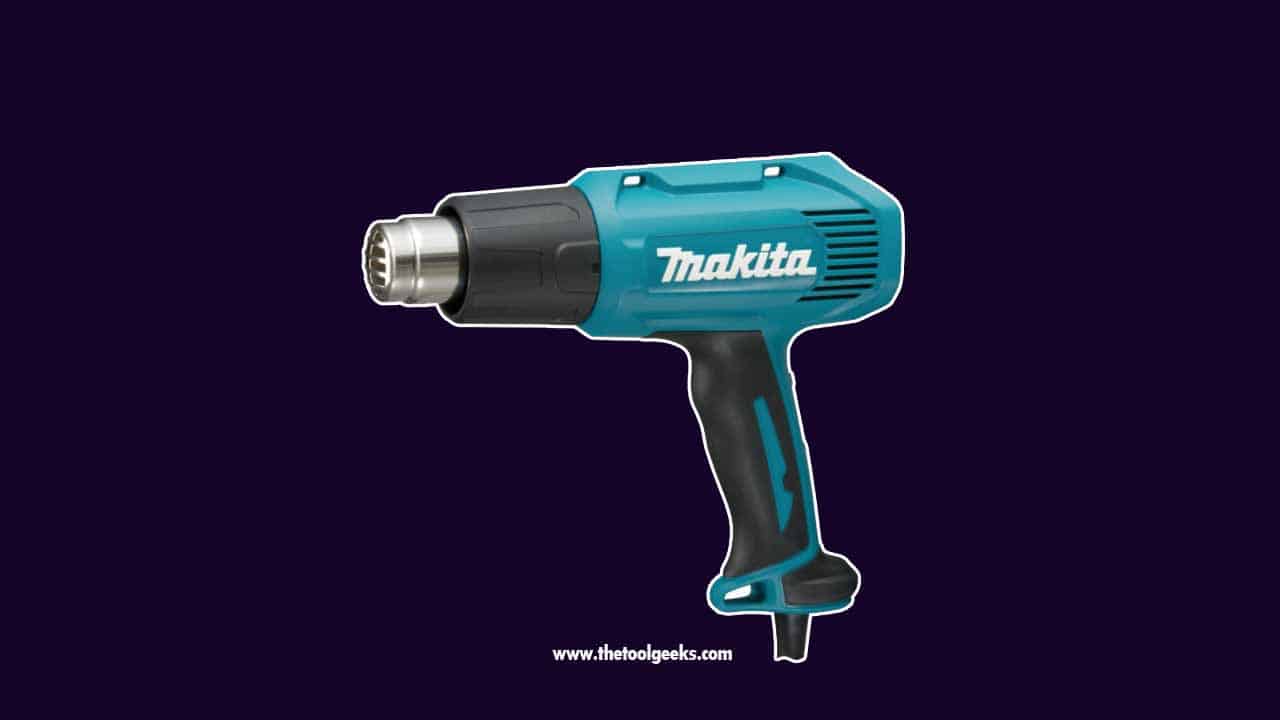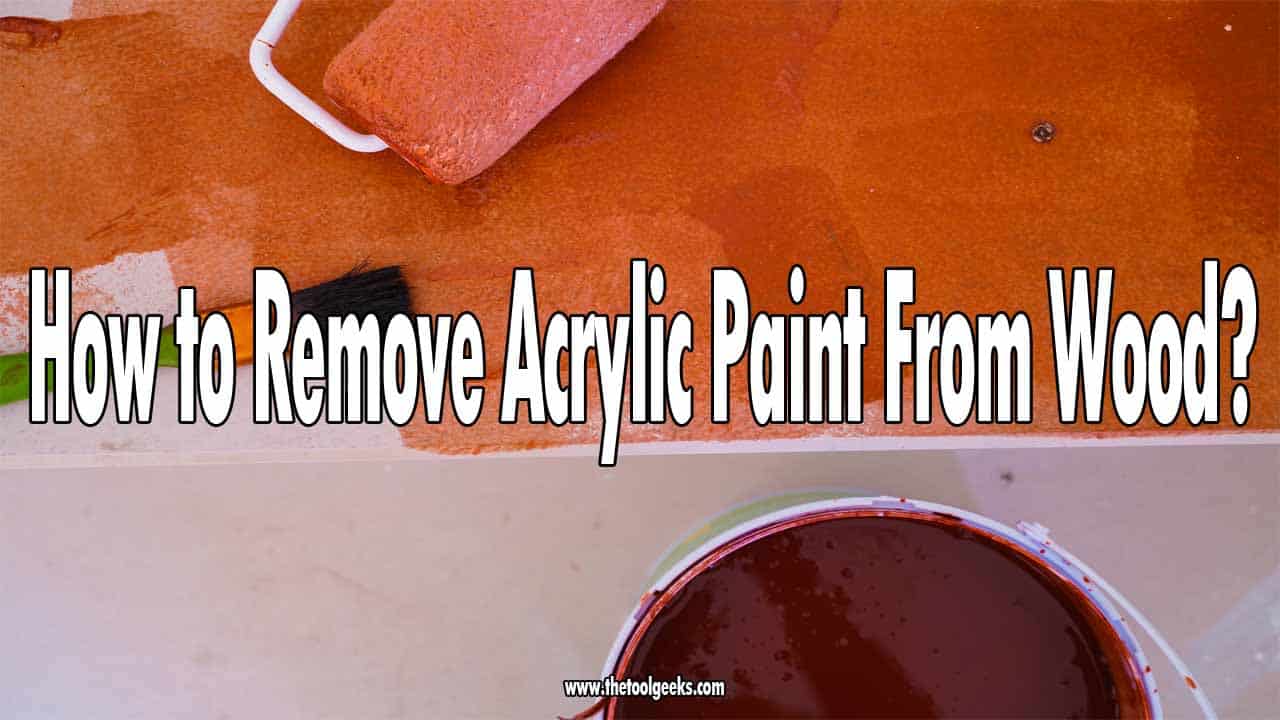How to Remove Acrylic Paint From Wood (Dry & Wet)
TheToolGeeks.com is a participant in the Amazon Services LLC Associates Program and other affiliate advertising programs. We may earn from qualifying purchases. (Learn More).
If you want to figure out the best method on how to remove acrylic paint from wood, then you are in the right place.
Many people use acrylic paint for various reasons so having an acrylic paint stain is very common. Either the paint stain was caused by you, your kids, or your house pets, it doesn’t matter because acrylic paint isn’t difficult to remove.
There are tons of methods that work effectively in removing acrylic paint from wooden surfaces and this post will teach you the most effective methods.
When you are done reading this post, you will be familiar with the most effective and pocket-friendly method that you can use to remove acrylic paint from wooden surfaces. So let’s get on with it.
Is It Difficult to Remove Acrylic Paint From Wood?
No, it is not difficult to remove acrylic paint stains from wood. Acrylic paint is water-based paint and it can be removed from wood easily through different methods. Though your best bet is to clean the paint stain immediately it happens with lots of water, it is not always that simple.
This is because most times, we discover the paint after it has dried off and by then the paint is no longer water-soluble. So removing with water isn’t an option. Luckily, there are still different ways to remove dried acrylic paint from wood easily and quickly.
Also, most of the tools and products you will need to remove the paint stain either wet or dried acrylic paint are easily accessible and cheap too. You usually don’t need power tools or any sophisticated device to remove acrylic paint. All of these make the process of removal very easy and quick.
There are two types of acrylic paint stain.
Related Read— Airless Paint Sprayers Review
Wet Acrylic Paint
This occurs immediately the paint comes in contact with the wood. The paint is usually still wet and hasn’t dried off. This stain is easier to remove than dried acrylic paint. Depending on the size of the stain, a bowl of water, a clean rag, and some mild detergent should do the trick.
Add a bit of dish soap or mild detergent to a bowl of water. Then soak a rag in the soapy water and use it to wipe the stain off the wood.
This method works within the first few minutes that the paint spills on the wood. After about 20 minutes, the paint would have dried off and this method might not work to remove the stain.
This is because acrylic paint isn’t water-soluble after it dries, so you will most likely need a tougher solution than water and soap.
Related Read— Best HVLP Spray Guns
Dry Acrylic Paint
Usually, this occurs 20 minutes after the paint spill because acrylic paint dries quickly. Dried paint is tougher to remove than wet paint.
Dried acrylic paint is the most common acrylic paint because people don’t notice the paint stain when it’s still wet. The paint is usually noticed after you are done with the painting task or when you are cleaning afterward.
There is a slight chance that water and soap will work to remove the dried acrylic paint stain but if soap and water don’t work. Don’t worry. There are still different effective methods you can try out. So, let’s check out the best methods to remove dried acrylic paint stains.
Related Read— Oil vs. Water-Based Stain?
How to Remove Acrylic Paint From Wood?
Though any of the paint removal methods below will work to remove acrylic paint from wood, there is a pro tip you should try out.
This tip will help to soften the paint before you apply any of the methods below. You should add a few drops of olive oil to the spot or surface and leave it for about 30 minutes. After 30 minutes, use a paint scraper or a putty knife to remove as much paint as possible.
The olive oil will soften the paint making it easier to remove the paint stain. After you have used the scraper to remove as much paint as you can, you can go ahead to use any of the methods below.
Use Acetone or Rubbing Alcohol
Acetone or rubbing alcohol also known as Isopropyl is a great choice for getting rid of paint stain from wooden surfaces.
Acetone is the main constituent of many nail polish removers and it will work well for removing acrylic paint. Isopropyl on the other hand also works well as a cleaning solution.

For this method, you will need a bottle of acetone or rubbing alcohol, a clean rag, and a paint scraper or plastic putty knife.
If you skipped the olive oil step, then you need to use the paint scraper to remove as much paint as possible. You don’t need to use much force so you don’t damage the wood. Just scrape the paint gently. If you used the olive oil and scraper earlier, then you can skip this step.
Next, you should pour the rubbing alcohol or acetone on the clean rag and use it to wipe the stain. Since the acrylic paint is water-based, you should see the paint starting to come off as you wipe. You can repeat this process up to 3 times.
After you have completely wiped off the paint, use a damp cloth to clean the spot. You can add a little soap to the rag as you clean.
The reason for cleaning the spot is to remove any paint residue or solution (the acetone or isopropyl) from the spot. If the solution is left on the spot, it can damage the wood so use a damp rag to clean the spot and leave it to dry.
Pros
- Acetone or Isopropyl works great to remove acrylic paint from wood.
- Acetone and Isopropyl are eco-friendly so you can use them indoors too
- This method is economical. Isopropyl and Acetone are easily accessible and cheap products.
- This method is easy to use.
Cons
- Too much acetone or rubbing alcohol can discolor your wood
- The solution though eco-friendly can cause skin irritation and redness
- Acetone and Isopropyl are fire hazards. Both products are very flammable.
Safety Precautions
- You should always put on a pair of gloves, a breathing mask, thick clothing, and a pair of goggles before using this method. Though the solution is eco-friendly, it can cause skin redness or swelling if you have sensitive skin. Even if you do not, it’s best to avoid contact with the solution.
- Do not mix acetone with Isopropyl. The result can be dangerous. You should just use one or the other.
Related Read— Best Spray Gun for Lacquer
Use a Heat Gun
Another method to remove acrylic paint is to use a heat gun. This method involves exposing the stained area to the high temperature from the heat gun.
The temperature is usually over a thousand degrees Fahrenheit and this will cause the paint to bubble and peel off itself within seconds.

To use this method, you will need a heat gun, breathing protection, a clean rag, and a pair of thick gloves that can withstand heat.
Start by putting on a pair of thick gloves. The heat from the heat gun can cause burns and bruises if you aren’t careful so use a pair of gloves to prevent getting burned. Then clean the affected spot with a clean rag so you can get rid of the dirt and debris on the spot. After that, plug in the cord of the heat gun and turn it on.
Slowly, hover the heat gun around the stained surface till you see the paint start to bubble. This should take a few seconds.
When you see the paint bubbles starting to form, you should stop and use a soft brush to remove the paint. You wouldn’t need to use force.
As a pro tip, do not use the heat gun on a wooden surface for over a minute. Consistent exposure of the wood to heat will damage the wood.
Pros
- This method is very effective
- The method is by far the quickest method to remove acrylic paint from wood
- Heat guns are very easy to handle because of the lightweight and build. It’s similar to a hairdryer in terms of appearance but the heat from a heat gun is 10 times more than the heat from most hair dryers. So don’t misuse the tool.
Cons
- A heat gun produces heat of over a thousand Fahrenheit so it can cause burns and bruises if mishandled.
- Low-quality heat guns can pose a fire threat.
- The tool isn’t a great fit for removing paint from wood. If used wrongly, it can damage the wood.
Safety Precaution
- Always use a pair of thick gloves to prevent burns and bruises.
- Do not hover the heat gun over the wood for more than a minute. Doing that will damage the wood. If the paint doesn’t come off within seconds, try another method.
Related Read— How to Remove Paint from Your Fingers?
Use Paint Stripper
Paint strippers do exactly what the name state. They strip paint from surfaces. Paint strippers are chemical gel-like compounds used to remove paint from different surfaces without damaging the surface. There are different types of paint strippers out there so get the only recommended for wooden surfaces.

For this method, you will need a paint scraper, a paint stripper, a putty knife, a rag, a pair of gloves, breathing protection, and a brush.
Start by cleaning the stained surface with a clean rag to remove dirt and debris. If the surface is dirty or dusty, the paint stripping compound wouldn’t work well on the surface. After cleaning, use a putty knife to remove as much paint as possible.
Do not use force to remove the paint. What you are trying to do here is to remove the paint you can so the paint stripper can work well. If you can’t remove any paint, don’t sweat it. the paint stripper will take care of that for you. Just ensure you are using a paint stripper recommended for wood.
After scrapping the paint off, use the putty knife to apply the paint stripper to the stained surface. Use the putty knife to scoop some stripper out of the can and press it on the stained surface. Since it’s a water-based acrylic paint, a layer or two of paint stripper is enough. After applying the stripper, you need to wait a while for the stripper to work its magic.
The time frame needed for the stripper to work ranges from a few minutes to some hours. The time is usually indicated on the container, so check for that.
For water-based acrylic paint, it shouldn’t take up to 30 minutes. After the stated time frame has elapsed, use a brush to gently scrub the area. Paint strippers are usually so strong that you will see the paint coming off while scrubbing.
After the paint has come off, use a clean rag, a bowl of water, and dish soap to clean the spot. This helps you get rid of any excess paint stripping paste and any lefto0ver stain.
Pros
- This method is very effective and will remove the toughest acrylic stains.
- This method is easy to use as you don’t need any power tool.
- Paint stripper is great for removing multiple layers of paint.
Cons
- This method is time-consuming. Some paint stripping products can take over an hour to work well.
- Paint strippers are toxic. Paint strippers remove paint by triggering a chemical reaction on the paint. This chemical reaction most times produces fumes. Inhaling the fumes into your lungs can be dangerous.
Safety precaution
- Put on a pair of gloves, eye protection, and a breathing mask to protect yourself from potential health concerns.
Sand the Stained Spot
Another great method to get rid of dry acrylic paint is to sand the stained area. Sanding the spot will get rid of any paint and dirt on the surface leaving you with a smooth and paint-free wooden surface.
Depending on the size of the stain, you can either sand manually or use a sander. For this method, you will need a pair of work gloves, rags, a dust mask, a pair of goggles, and depending on the size of the stain, fine-grit sandpaper or an electric sander.
Start by cleaning the spot with a clean rag to expose the paint stain. If you have a small stain or you are working on a finished wooden surface, you should use fine-grit sandpaper, like 80-grit to 120-grit sandpaper to sand the area gently.
Move the sandpaper in a circular motion till you see the paint coming off. The reason for using fine-grit sandpaper is because you are dealing with a light paint stain. Also, if you use coarse sandpaper on a finished wooden surface, you will ruin the finish of the wood.
If you have a large paint stain or you are working on rough wood or lumber, you can use a sander and sanding discs. Get an 80-grit sanding disc and attach it to the sander. Then use the sander to sand the area gently. You should always inspect the surface at regular intervals to check where you still have paint stains on the wood.
When you don’t have any paint stain anymore, stop sanding. Then use a soft brush or a clean rag to clean the area. Depending on the condition of the wood after sanding, you might need to refinish the wooden surface.
Related Read— The Estimated Cost of Painting Your Garage Floor?
Pros
- Sanding the affected spot will remove the paint and grime from that spot.
- This method is economical. Except in extreme conditions when you need to buy an electric sander and sanding discs, you wouldn’t need to spend much on this method. Ordinarily, all you need is 80-grit sandpaper and a pack would cost less than $5.
Cons
- This method can be tedious if you are sanding a large area manually.
- The sandpaper will most likely ruin the finish on the wood so you will have to refinish the wood afterward.
Safety precaution
- Always put on breathing protection and a pair of goggles especially when using a sander. Sanding produces a lot of dust. Without breathing protection, you will inhale the dust and it can get in your eye too.
Related Read— How to Strip Paint off Concrete?
Pro Tips to Follow While Removing Acrylic Paint From Wood
Though removing acrylic paint from wood is easy, there are a few tips you should follow.
- Always read and follow instructions. There are instructions usually indicated on the container of whichever product you are using. These instructions give directions on how to use the product. For instance, there would be instructions indicated on the can of the paint stripper regarding how to apply the product.
- Only use products recommended for wooden surfaces. Others can damage the wood
- Never mix cleaning solutions. The result can damage the wood, cause a chemical reaction, and even harm you.
- Do not clean beyond the affected spot. Using a paint stripper or any other solution on bare wood can discolor the wood. Only clean the stained spot.
So there you have it. You can use any of the methods above to successfully remove acrylic paint stains, either wet or dry from wooden surfaces.
If you have any questions or comments about how to strip acrylic paint from wood, you can leave them below and I’ll attend to them as soon as possible.
Related Read— How to Spray a Truck?
Amazon and the Amazon logo are trademarks of Amazon.com, Inc, or its affiliates.

